From: https://custom-writing.org/blog/student-activism-101-how-to-find-your-cause-get-started
Student Activism 101: How to Find Your Cause & Get Started
Today, the voices of student activists are ringing louder than ever before, challenging the status quo and demanding a brighter future for all. Some think it’s a new trend, but this is not true. Student activism has been a mainstay of college life ever since the emergence of the first universities and has contributed to many significant causes.
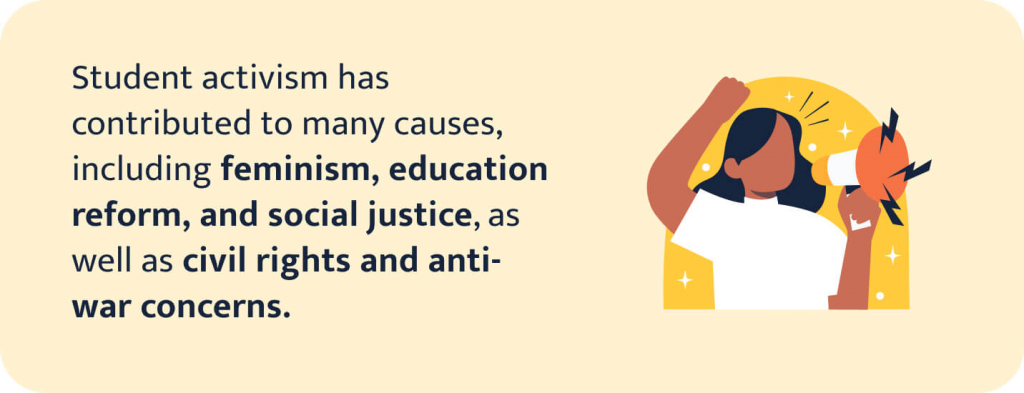
Students today have discovered new ways to draw attention to burning issues. Technology and social media have become powerful tools for young activists to amplify their voices and inspire change on a global scale.
So, do you want to protest against injustice?
Or maybe you want to help in the battle against global warming?
If so, then activism is an excellent option for you!
In this article, our custom-writing experts will tell you about the main types of activism, how to choose one that suits you, and how to start being an activist in college. Plus, there will be an awesome infographic and a bonus at the end!
📜 The History of Student Activism
So, what is student activism? It’s the collective action taken by students to bring about change, whether political or social. It involves advocating for a cause, raising awareness, and campaigning for specific issues. Students have been engaged in activism for centuries, participating in everything from anti-war protests to demonstrations against tuition increases.
Since its inception, campus activism has significantly impacted the evolution of higher education and society as a whole. Students have pushed colleges to eliminate discriminatory rules, boost campus security, and enhance the student experience for generations to come.
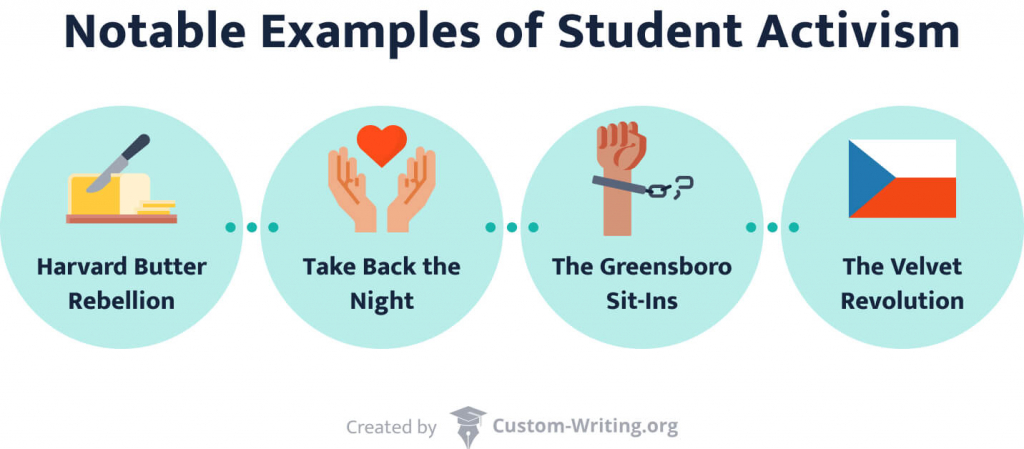
There have been many inspiring examples of student campaigns throughout history. Below, we’ll discuss some of them in more detail.
The Harvard Butter Rebellion
In 1766, Harvard University’s students became fed up with having to eat rancid butter in their cafeteria. When their patience ran out, they staged a massive protest. The issue was settled when the headmaster stepped in, substituting rancid butter with good-quality butter.
Take Back the Night
In 1972, students from the University of South Florida marched, demanding a safer campus for women. This demonstration inspired Take Back the Night—an international movement seeking to end all types of domestic and sexual abuse. Hundreds of events related to this movement occur annually in more than 30 nations worldwide.
The Greensboro Sit-Ins
The Greensboro sit-ins are among the first peaceful protests of civil rights activists. In 1960, a group of Black students from North Carolina Agricultural and Technical College sat at the lunch counter for White students only and refused to leave despite threats from authorities. This way, they wanted to attract people’s attention to the problem of segregation. They are credited with sparking a much larger sit-in movement with more than 70 000 participants.
The Velvet Revolution
It’s hard to believe, but the famous 1989 Velvet Revolution in Czechoslovakia was possible thanks to proactive students that participated in rallies against the Communist Party of Czechoslovakia. As a result, the country’s 41-year one-party dictatorship came to an end, and a parliamentary republic was established.
🎓 Student Activism Today
There has never been a better time to become an activist than today. Students, teachers, politicians, and celebrities across the world actively participate in important political and cultural movements.
In addition to rallying in the streets and working behind the scenes in activist organizations, they influence politicians and assist in crucial events such as elections, suppression of police brutality in the United States, and many more. Activists are now as powerful and free as ever.
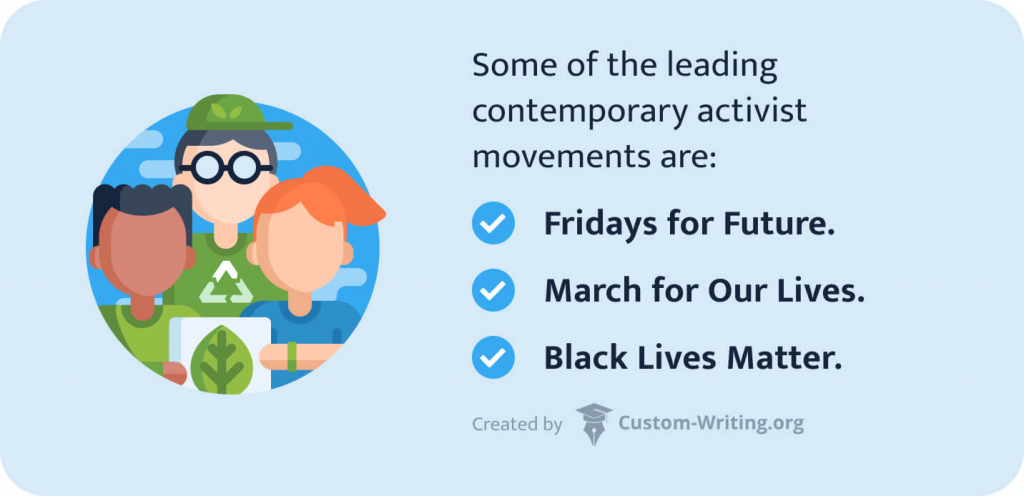
Some of the leading contemporary activist movements are:
👍 How Student Activism Helps Make a Change
Student activism has always had a substantial impact on our society. With the advent of social media, this influence has grown exponentially. Here are some recent examples of how student activism has improved our lives.
Example #1
Student protesters today emphasize supporting gun laws, and they have inspired many young people to participate in the 2018 elections. A survey conducted by CIRCLE at Tufts University found that youths involved in the gun violence prevention movement were likelier to vote in the 2018 midterms. Increased media coverage of young activists has also contributed to the growth in youth voter registration and turnout in 2020.
Example #2
In 2018, European mass media was shaken by a 16-year-old Swedish girl, Greta Thunberg. At 15, she began spending her Fridays outside the Swedish Parliament to advocate for more aggressive climate change action. Thunberg first came to public attention due to her young age and direct speaking style.
In her speeches, she criticizes political leaders for not doing enough to address the global warming. Now, thousands of students around the world leave their classrooms on Fridays as part of a global international climate strike led by Thunberg.
Example #3
Activism can also be used to demand changes on a smaller scale—for instance, in your local community or college. In 2015, Virginia Commonwealth University students insisted on hiring more professors of color, and their demands were met.
Aside from being inspiring, all these protests are peaceful and comply with the principles of democracy.
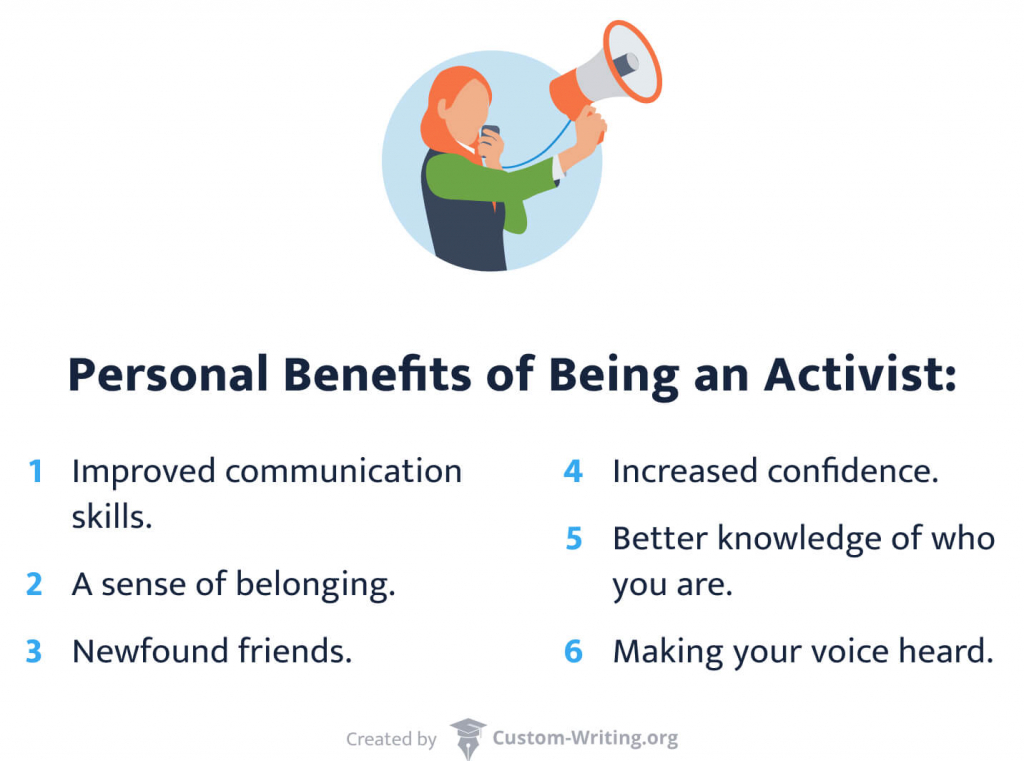
🙋 The Public Perception of Activism
It’s hard to believe it, but there were times when social justice activists were mostly seen as hooligans, puppets of the authorities, or just incompetent people who didn’t understand what they were talking about. Today, there still are people who share this opinion, but there are much fewer of them.
You may be wondering, what makes people be suspicious of activists? Well, there are several answers to this question:
Examining surveys from several student protests throughout history, we can see that, compared to 50 years ago, society now views student activism very differently. A 1969 poll reveals that only 34% of Americans interviewed thought that student protesters could be trusted, while 54% said it was best to be cautious around them.
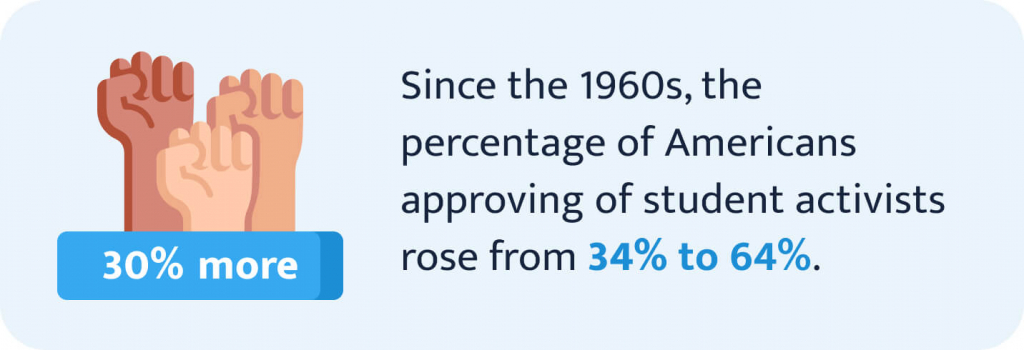
But what about now? According to a recent poll from March 2018, the majority of the American public (64% of interviewees!) supports students speaking up for themselves on television and in other media.
We can see that nowadays, authorities understand more than ever that they need to listen to young people’s voices. The public perception of activism is becoming more and more positive, and activists are gaining more strength and influence in the media.
The Main Types of Student Activism
So, you’ve decided to become an activist. That’s great news! But first, you need to learn about the details. Let’s start with analyzing the main types of activism that are relevant today. We will consider different methods and causes.
Different Methods
The main methods by which students can practice activism are the following:
Different Causes
Now let’s talk about the problems that we, as a society, must deal with, and you, as an activist, can help to solve. We’ve also included some resources related to each cause that you may check out.
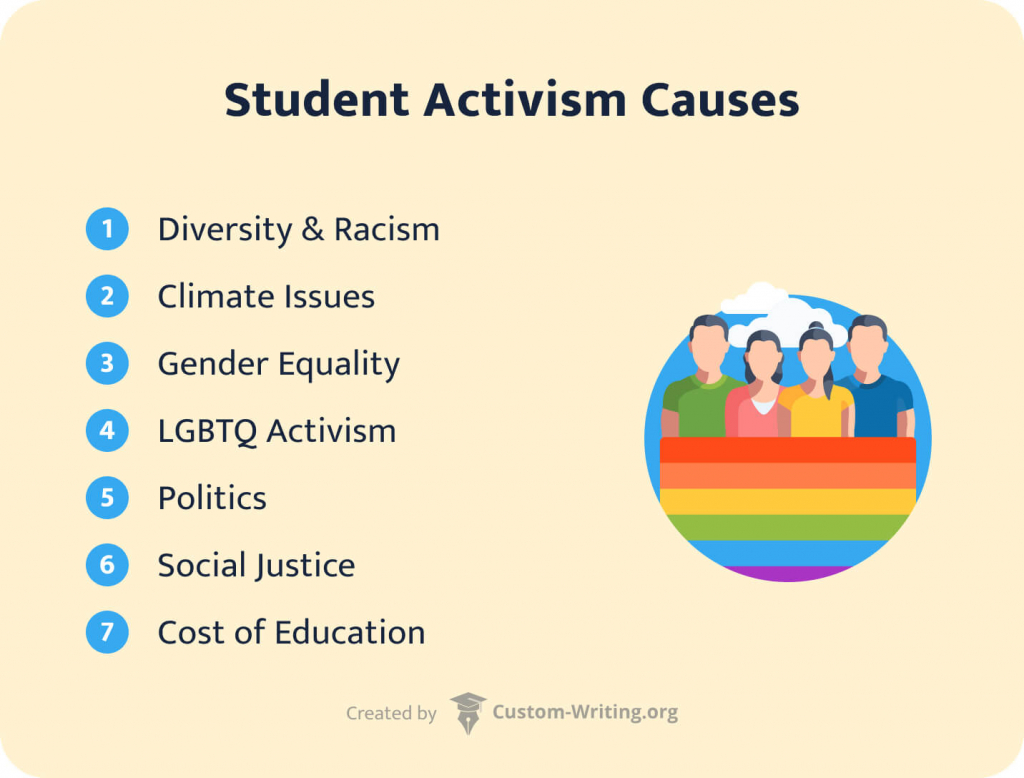
Diversity & Racism
Although the Civil Rights Movement began more than 50 years ago, racism and a lack of diversity still exist on college campuses and in the rest of the nation. Racial tensions can linger and eventually threaten people’s safety. That’s why activism in racial justice causes is as important as ever.
Resources:
| 🌐 Racial Justice Resources: Justice for Black Lives | This page at National Education Association contains plenty of great multimedia resources and texts related to racial issues and ways to combat them. |
| 🌐 Diversity, Equity, and Inclusion | This is a comprehensive list of resources on DEI curated by American Nuclear Society. Check it out to learn about various facets of diversity and inclusion. |
Climate Issues
The most dangerous consequences of climate change now include intense droughts, water scarcity, destructive fires, rising sea levels, flooding, and melting polar ice. Human influence on nature is also a big topic to discuss.
Resources:
Gender Equality
Gender discrimination still exists in political and economic spheres. Despite considerable advances over the years, women still earn on average 20% less than men in the worldwide labor market. But that’s just a part of it—the issue of inequality also includes gender-based violence, harassment, and workplace discrimination.
Resources:
LGBTQ Activism
LGBTQ persons have long faced discrimination in the workplace, housing, military, and other spheres. Student activism is especially progressive in this area. Numerous college groups unite LGBTQ students and allies, creating an inclusive environment and finding new ways to make the world more just.
Resources:
Politics
Students champion many political issues on college campuses, be it anti-war demonstrations or dissatisfaction with the country’s foreign and domestic policy.
Resources:
Social Justice
Social Justice
Social justice is a guiding principle that unites activists in achieving their shared objectives. These objectives include racial, ethnic, and socioeconomic equality, freedom from discrimination, and equal rights.
Resources:
Cost of Education
40% of students who start college don’t finish it due to high costs. Many graduates are ill-equipped to support themselves and pay off the debt they accrued while earning their degrees. All this makes the cost of education a topical issue among students.
Resources:
🤔
How to Choose a Suitable Type of Activism
Now you know about the many types of activism. But how do you choose one for yourself?
To do that, it’s essential to consider how you can use your unique talents to contribute to a cause. Find your strength or something you’re good at, and integrate it into your campaigning.
To make it easier for you, we’ve combined the types of activism with the necessary traits or skills. Check them out below, and you’ll surely find one that suits you!
Check out the infographic below to learn more about the various options you can choose from depending on your strengths and talents:
🏁 Getting Started: The First Steps to Student Activism
Now that you’ve chosen a direction for yourself and are ready to start becoming an activist, you need to know what your first steps should be. Don’t worry—we’ve got the answer. Read on to learn all about how to start on your path.
Here’s what you should do:
📌 Step #1. Discover your passion and find people who share it.
Finding people who share your interests is a great starting point for activism. Use activity fairs, notice boards, websites, and social media to find fellow activists.
📌 Step #2. Do your research.
Effective activism requires a thorough understanding of the problem at hand. Read reliable news sources, follow well-known campaigners on social media, and join clubs that focus on the issues you care about.
📌 Step #3. Determine your goal.
Make a list of your immediate, mid-term, and long-term objectives. This will help you stay organized and prepared for action.
📌 Step #4. Create an action plan.
Consider everything that must be done to accomplish your goal. Arrange the actions chronologically, starting with solutions to your immediate objective.
📌 Step #5. Use resources and collaborate.
To have strength in numbers, activists should get in touch with faculty or staff who can offer guidance. Don’t be afraid to reach out to national organizations and higher authorities.
📌 Step #6. Spread the word.
Always look for chances to tell people about the cause you’re campaigning for. You can hold informational meetings or make special announcements before major events.
📌 Step #7. Take action.
Once you’ve got a plan and a group of people to support you, you can begin organizing events, workshops, social media postings, and other activities to achieve your goals.
What If Being an Activist Is Not for You?
For various reasons, a person may not have the desire or opportunity to be an activist, even if they still want to help society. For example, someone may be afraid of being punished by authorities. They may also fear for their mental health, which is no joke, either—research shows that, despite all the benefits, 60% of activists experience adverse consequences of campaigning to their psychological well-being. These concerns are all valid, and there’s no need to be ashamed of them.
It’s important to remember that you don’t have to be an activist if it’s not something that interests you or aligns with your values. Everyone has the right to choose their path and make a difference in their own unique way.
In case you still want to make a contribution, there is no need to despair. We’ll tell you about alternatives to traditional types of activism. Sounds interesting? Keep reading!
Everyday Activism: How Small Actions Can Help a Cause
Instead of being a full-fledged activist, you can make a contribution through changes in your lifestyle through everyday activism.
Everyday activism is a set of small yet meaningful actions that you take on a daily basis to make a positive impact on the world around you. By engaging in them, you develop a mindset of intentional living and social justice that will serve you well during and after college. These actions can become lasting habits and help you make a difference in the world around you.
Everyday activism may include:
Bonus: Dos & Don’ts of Student Activists
So, here’s the promised bonus! Check out the following useful tips on what college activists should and shouldn’t do during demonstrations and other events.
Do:
DON'TS:
Activism is always a choice. No one forces you to become an activist, but if you choose to become one, then go for it! It doesn’t matter what you’re going to campaign for. Everything you do will count.
We sincerely wish you luck on your path to making our world a better place! Feel free to tell us your ideas in the comments and share this article with other aspiring activists.
🔍 References





A useful post for teachers discussing activism especially if an educator is discussing the future (especially the environment) with associates, friends, and students.